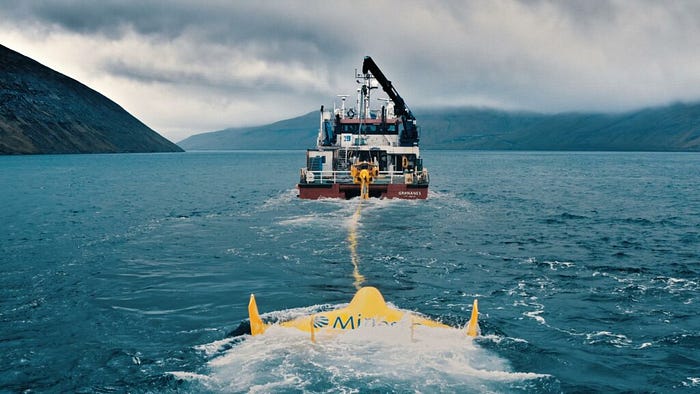Here's a question, what's the lowest carbon form of energy? Solar? Wind? Maybe nuclear? Well, if you guessed tidal, you'd be right. Don't get me wrong, nuclear, wind, and solar have amazingly low emissions at 4g per kWh, 4g per kWh and 6g per kWh, respectively. Tidal, on the other hand, has more than 50% less emissions than nuclear or wind at just 1.8g per kWh! So why don't we use it more? Well, for years, it has been extortionately expensive and utterly impractical. But, thanks to Minesto's Dragon 12 tidal power kite, that might be about to change and usher in a new era of insanely cheap, ultra-low carbon energy.
So, why is tidal energy so damn efficient? It's all to do with density. Let me explain.
Tidal energy works the same way as wind energy. As the water flows past, it spins a turbine, which turns a generator and creates useable energy. But, as water is nearly a thousand times denser than air, it holds far more kinetic energy when moving at the same speed. This increase is so dramatic that a litre of water moving at 1 meter per second (2.2 mph) has the same kinetic energy as a litre of air moving at 27.84 meters per second (62.3 mph). Moreover, there are plenty of places on Earth where tides regularly exceed 1 meter per second twice daily. Almost nowhere on Earth has predictable 27.84 meters per second winds daily. The far higher kinetic energy content of tides combined with their regularity means that a far smaller tidal turbine will create way more energy over a year compared to a giant wind turbine.
The problem has been building tidal turbines that are cheap, easy to install and easy to maintain whilst still being robust enough to last in the incredibly harsh environment of the ocean.
Enter Minesto's revolutionary Dragon 12. The Dragon uses a kite design rather than being a turbine built up from the sea floor. It resembles an underwater plane with a giant 12-meter wingspan and a large propeller that's actually a turbine hanging off the back. As the tide flows over the Dragon, it 'flies' in the water. A control module onboard steers it in a figure-of-eight path. This increases the flow over the turbine, dramatically inflating its energy output for the same tide speed. Kite boarders use the same concept to jump tens of meters in the air by looping their kite.
This isn't Minesto's first foray into tidal power. This kite concept was pioneered by their much smaller Dragon 4 unit, which was only rated at 100 kW, making it useless for commercial operations. The much larger Dragon 12 can pump out up to 1.2 MW of power. This means that over the course of a year, the Dragon 12 can produce the same amount of energy as multiple wind farm turbines. What's more, its larger size makes it suitable for far deeper locations. This allows the Dragon 12 to carve a much larger figure of eight, enabling it to produce the same amount of power with far less tidal flow. Most tidal energy requires tidal flows to have a minimum peak of at least 2.5 meters per second, which you can only find in tidal pinch points like the mouths of large bays. But the Dragon 12 can operate in peak flows of as little as 1.5 meters per second, which you can find in some open water locations. This high output per unit, combined with its ability to be installed in a far wide variety of locations, makes the Dragon 12 one of the most viable tidal technologies out there.
But it gets better. The Dragon 12 can be disassembled and shipped inside a single shipping container. It can then be easily assembled and launched by a small boatyard and can be towed out and installed by a small ship. It also makes maintenance easy, as rather than trying to fix it in situ, the unit can be detached from its tether and returned to land for minimal cost. This dramatically lowers the cost of installation and maintenance, which is one of the biggest costs of tidal energy.
This is why it is huge news when Minesto recently announced that the Dragon 12 has delivered its first energy to the grid on February 9th in the Faroe Islands. That's right, this isn't some concept in development; it is already in action, producing electricity for people and businesses.
As there is only one Dragon 12 unit, its energy price is likely still relatively high. But Minesto has said that after they have installed 100 MW or 84 Dragon 12 units, the cost will drop to $108 per MWh, or just a little cheaper than the cheapest nuclear power. But, after that, Minesto predicts prices will fall to as little as $54 per MWh, which is the same cost as the cheapest solar energy or wind power combined with the energy storage costs they need to make them viable. For some sense of how impressive this is, the current cost of tidal energy is around $188 per MWh, meaning the Dragon 12 represents a potential 70% drop in cost!
So, while tidal power is a fringe energy source right now, don't be surprised if it soon explodes and becomes one of the most sought-after climate technologies out there, thanks to Minesto.
Thanks for reading. Content like this doesn't happen without your support. If you want to support content like this, or read articles early, go and follow me and my project Planet Earth & Beyond or follow me on Bluesky or X.
(Originally published on PlanetEarthAndBeyond.co)
Sources: Minesto, IE, News Atlas, Will Lockett, Lazard, Marine Energy Wales, Carbon Brief


